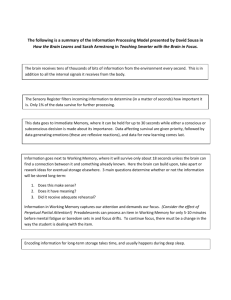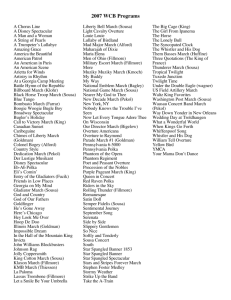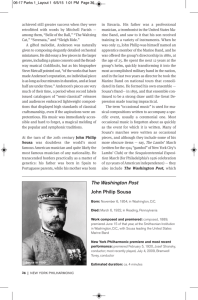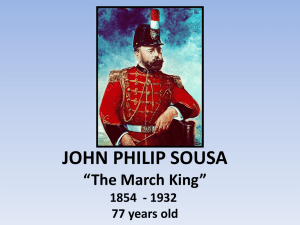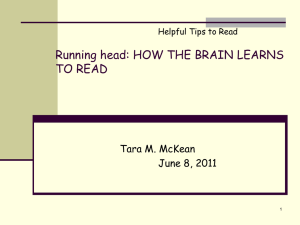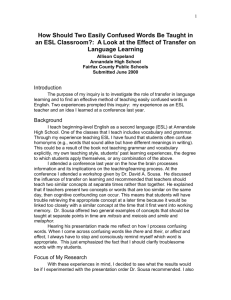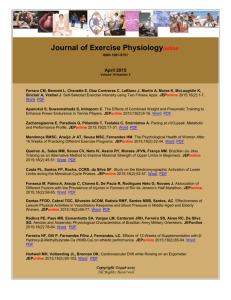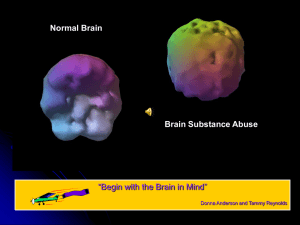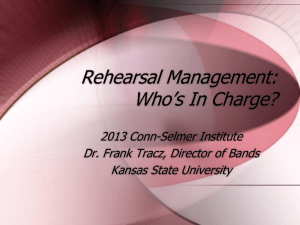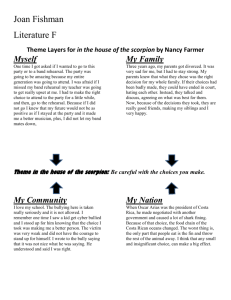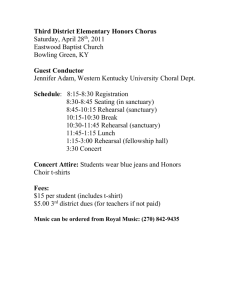Literature Review Module 1 – How the Brain Learns - NC-NET
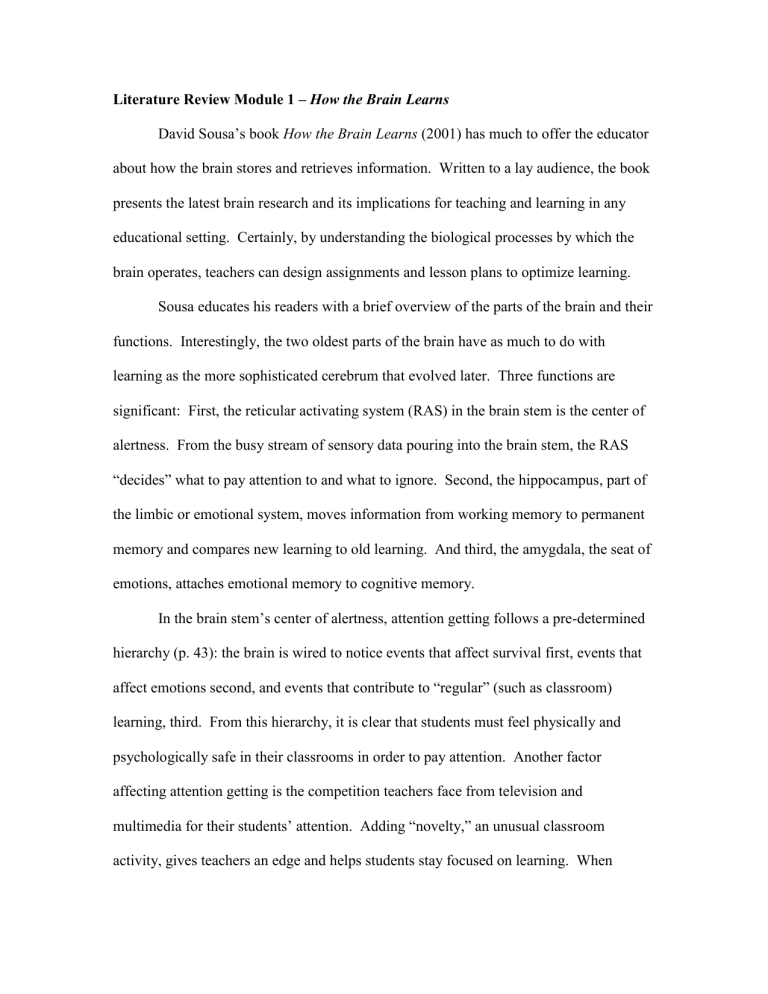
Literature Review Module 1 – How the Brain Learns
David Sousa’s book How the Brain Learns (2001) has much to offer the educator about how the brain stores and retrieves information. Written to a lay audience, the book presents the latest brain research and its implications for teaching and learning in any educational setting. Certainly, by understanding the biological processes by which the brain operates, teachers can design assignments and lesson plans to optimize learning.
Sousa educates his readers with a brief overview of the parts of the brain and their functions. Interestingly, the two oldest parts of the brain have as much to do with learning as the more sophisticated cerebrum that evolved later. Three functions are significant: First, the reticular activating system (RAS) in the brain stem is the center of alertness. From the busy stream of sensory data pouring into the brain stem, the RAS
“decides” what to pay attention to and what to ignore. Second, the hippocampus, part of the limbic or emotional system, moves information from working memory to permanent memory and compares new learning to old learning. And third, the amygdala, the seat of emotions, attaches emotional memory to cognitive memory.
In the brain stem’s center of alertness, attention getting follows a pre-determined hierarchy (p. 43): the brain is wired to notice events that affect survival first, events that affect emotions second, and events that contribute to “regular” (such as classroom) learning, third. From this hierarchy, it is clear that students must feel physically and psychologically safe in their classrooms in order to pay attention. Another factor affecting attention getting is the competition teachers face from television and multimedia for their students’ attention. Adding “novelty,” an unusual classroom activity, gives teachers an edge and helps students stay focused on learning. When
students associate new learning with something they already know, learning is infused with personal meaning and therefore more easily retained and retrieved. Therefore, teachers should allow time in the classroom for these associations to take place.
Certainly, the news that people remember events charged with strong emotions--either positive or negative—is not new, so capitalizing on positive emotions becomes a strategy for the classroom teacher.
The cerebrum, the newest addition to the brain, is the executive center of the brain, responsible for the higher-order thinking, reasoning, and problem solving that we associate with higher education. This part of the brain also keeps the emotions of the amygdala in check by acting as the seat of self-will. Significantly, here is where working memory takes place. Here are also the two hemispheres of the brain, in which some specialization of brain function takes place, and the corpus callosum, which transports messages from one hemisphere to the other.
Sousa likens the brain’s functions to that of a parallel processing system (p. 39) and uses the Information Processing Model in Figure 1 to illustrate the method by which the brain places information into long-term storage.
Figure 1. Information Processing Model
Note: Adapted from Sousa, D. (2001). How the Brain Learns , (2 nd
ed.). Thousand Oaks,
CA: Corwin Press
Information brought in through the senses is first screened by the Reticulating
Activating System, depicted in Figure 1 as the sensory register, which allows sensory data to pass into Immediate Memory according to a predetermined hierarchy. If immediate memory decides that the information will be needed later, it sends the information to working memory. Working memory, in the frontal cortex, then determines if the information has sense and/or meaning for the individual. Sousa’s model includes self-concept, largely based on past experience, which determines the degree to which students believe they can or cannot learn. Self-concept, together with the memories in long-term storage, makes up an individual’s personality expressed in
Sousa’s model as the cognitive belief system.
The attaching of sense and meaning to new learning is significant to teaching. The greater the degree of sense and meaning, the greater the likelihood that information will be passed on to long-term storage. First, the brain tries to make logical sense of the information. Then, the brain seeks to endow the information with personal meaning. The presence of both sense and meaning helps to move information to long-term storage. In the absence of sense, meaning becomes more important (pp. 46-48).
Sousa explains the structure of a brain cell, called a neuron, and describes how stimuli traveling down the axon of a neuron release neurotransmitters jump across a tiny gap between neurons called a synapse. The nerve impulse is picked up by tiny branches from a neighboring neuron called dendrites. Memories are formed when a group of neurons is stimulated to form a pattern of responses. Repeated firings of this group of neurons create a memory trace, or engram (p. 80).
Just as muscles improve with exercise, the brain seems to improve with use.
While learning does not increase the number of brain cells, it does increase their size, their branches, and their ability to form more complex networks. "Learning" says Sousa,
"occurs by changing the synapses so that changes the influence of one neuron on another also changes" (p. 22). The more complex the skills demanded of a particular occupation the more dendrites are found on the neurons. The presence of more dendrites allows for more connections between neurons resulting in more sites in which to store all learning— including memories, words, faces, music, motor skills, and emotions. The amount of information that can be stored seems limitless. There are 100 billion neurons in the adult brain. Each neuron can have up to 10 thousand dendrites. This means that it is possible to have up to one quadrillion (1 followed by 15 zeros) synaptic connections in one brain.
Teachers can aid the process of learning by capitalizing upon the brain’s ability to chunk information while it is in working memory. Chunking is when the brain perceives several pieces of information as one item. Most adults can handle up to seven items, or chunks, in working memory at one time. The ability to chunk has more to do with how a person has organized his or her knowledge base and less to do with the way he or she perceives. Working memory is limited in how many chunks it can process at one time but the number of items into each chunk appears to be limitless (p. 120) .
Learning is not synonymous with retention. Learning is the process of acquiring information and "involves the brain, the nervous system, the environment, and the process by which their interplay acquires information and skills" (p. 84). Retention is the act of retaining knowledge and skills for the future and "requires that the learner not only give conscious attention but also build conceptual frameworks that have sense and meaning for eventual consolidation into the long-term storage networks" (p. 84). In the classroom, retention is affected by the teaching method, the timing of information presented, transference or the influence of prior learning, and the length and type of rehearsal.
Teaching methods that involve students in the learning process increase retention rates. For example, students remember as much as 90% of information they teach others and 75% of what they practice by doing. Yet students remember only 10% of what they read and only 5% of what they hear in a lecture (p. 95).
By using the first and last segments of class to present the most important information, teachers can make use of the primacy-recency effect, the tendency to remember what comes first, best , what comes last, second, and what comes in the middle,
third . The first and last segments of class are prime-time learning opportunities. The middle section is described as down-time. Teachers can even break up longer classes into shorter learning episodes, since the proportion of prime-times to down-times decreases with the length of the lesson taught (pp. 88-93).
The transfer of learning is a two-part process involving the effect of former learning on new learning and the possibility that the new learning will be used in the future. Factors promoting transfer include the similarity of situations and learning; critical attributes that distinguish one concept from others; association of events or feelings in which the recall of one helps to remember the other one; and the context and degree of original learning. Sousa says that "significant and efficient transfer occurs only if we teach to achieve it," for transfer does not automatically occur just because students have amassed base of knowledge (p. 146). "To use transfer effectively, teachers need to identify factors that facilitate learning (positive transfer) while minimizing or eliminating factors that can cause interference (negative transfer)" (p. 140). Teachers can help students transfer new learning to former learning, and they can also help prepare students to transfer new learning to future situations.
Adding sense and meaning to new learning occurs only if the student has enough time to process and reprocess it during an activity called rehearsal. During rehearsal a student can review information, make sense of it, elaborate on details, and attach value and relevancy to the learning. While rehearsal contributes to long-term memory, it does not guarantee it; however, “there is almost no long-term retention without rehearsal” (p.
86). Two things affect rehearsal: “amount of time devoted to it, which determines whether there is both initial and secondary rehearsal, and the type of rehearsal carried out,
which can be rote or elaborative” (p. 85). Sousa talks about two kinds of rehearsal (p.
86): Rote rehearsal, used when learner needs to remember and store info exactly as it is processed in working memory, depends on repetition as in learning a phone number or the lines to a part in a play. Elaborative rehearsal is used when it is not necessary to store information exactly as is in working memory but when it is more important to associate new learning with prior learning to see relationships. Elaborative rehearsal strategies include paraphrasing shorter segments and summarizing longer ones, note taking and conscious selection of the more significant notes, predicting what is going to happen or what information will be presented next, questioning from lower-level thinking of recall to comprehension to synthesis and evaluation, and engaging in Think—Pair—Share activities in class.
One way to help students rehearse is by spending more time on the item while it is in working memory. Increasing a student’s motivation will also increase the time he or she spends on rehearsal. Teachers can increase students’ level of concern about their classes. According to Hunter (1982), “too little concern results in little learning. Too much concern results in heightened stress about learning” (cited in Sousa, 2001, p. 67).
Information stored in long-term memory sites is not useful if students can’t retrieve it. Retrieving a memory from long-term storage is accomplished in two ways: through recognition and recall. Sousa reports that the rate of retrieval depends on several things: the adequacy of cues, the mood of the retriever, the context of the retrieval, the system of storage (pp. 106-107). Sousa gives a number of suggestions to give students enough opportunity to recall information from long-term storage. One suggestion is to allow enough wait time before hearing responses from students. In studies first
conducted by Mary Budd Rowe (cited in Sousa, 2001) the average wait time between question and response from a high school teacher was one second. Elementary school teachers waited three seconds. When teachers postponed wait time to five seconds or more they found that “the length and quality of student responses increased, there was greater participation by slower learners, students used more evidence to support inferences, and there were more higher-order responses.” The teachers, too, improved their teaching by “us[ing] more higher-order questioning, demonstrat[ing] greater flexibility in evaluating responses, and improv[ing] their expectations for the performance of slower learners” (p. 128).
In addition to implementing strategies to aid retention, understanding the specialized work of the left and right hemispheres can help teachers accommodate differences in students’ natural thinking preferences. According to Sousa, research reveals that most people have a strong or mild hemispheric preference, which helps determine personality, abilities, and learning style. People with a left-hemisphere preference tend to have more verbal, analytical, and problem-solving skills, and those with a right-hemisphere preference tend to have more math, artistic (drawing, painting), visual skills. (p. 171)
Sousa cautions that brain “specialization does not mean exclusivity,
” (Sousa’s boldface) and “both hemispheres are capable of synthesis, that is, putting pieces of information together into a meaningful whole” (p. 170). Even though one hemisphere may be the center of a particular specialization, such specialization is not confined to one hemisphere. For example logic is not confined solely to the left hemisphere and creativity or insight is not confined solely to the right hemisphere.
Sousa suggests we teach to both hemispheres and gives a number of suggestions
(p. 175) for teaching to the whole brain: alternate discussion with visual models, place words on overheads or the board to give visual clues, present concepts logically and intuitively, make sure that words and tone match body language.
Using brain research to design classroom activities has much potential. By paying attention to the physiological processes involved in learning and retention, teachers can have an opportunity to make the best use of time spent in the classroom.
Sousa's book is by no means the only text that offers teachers strategies for improving learning. Other sources include M. Banich's Neuropsychology: The Neural Bases of
Mental Functio n, Caine and Caine's Making Connections: Teaching and the Human
Brain , and Davis' Mapping the Mind: The Secrets of the Human Brain and How it Works .
Indeed, more research is needed by the members of the Learning Dynamics team to validate and extend Sousa's presentation of material.
Sousa, David (2001). How the Brain Learns . Thousand Oaks, California: Corwin Press.
